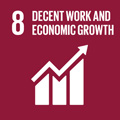- Docente: Mariagiulia Matteucci
- Credits: 8
- SSD: SECS-S/01
- Language: Italian
- Teaching Mode: Traditional lectures
- Campus: Rimini
- Corso: First cycle degree programme (L) in Statistics, Finance and Insurance (cod. 5901)
-
from Sep 17, 2024 to Dec 04, 2024
Learning outcomes
At the end of the course, students know the basic concepts of statistical methodologies for taking business and financial decisions, and models for accounting and financial data for credit scoring.
Course contents
- Introduction to statistical methods for credit scoring.
- Recall of categorical variables: marginal and conditional independence, measures of association.
- Logistic regression model: model specification, estimation and interpretation of model parameters, variable selection, goodness of fit.
- Discriminant analysis: canonical discriminant analysis, model-based discriminant analysis.
- Classification trees: CART and CHAID methods.
- Methods for the estimation of the classification error and for the evaluation of the performance of the classifier.
- Basics of neural networks.
- Basics of latent variable models: latent class analysis.
- Recall of cluster analysis for its use in credit scoring.
For each topic in the list, an analysis of case studies will be carried out by using the software R (at least 2 hours per week).
Readings/Bibliography
Compulsory reading
- Elena Stanghellini (2009) "Introduzione ai metodi statistici per il credit scoring", Springer-Verlag. Available as Unibo e-book.
- Teacher's lecture notes available on the platform Virtual Learning Environment at: virtuale.unibo.it
Suggested textbooks
- Stefania Mignani, Angela Montanari (1997) "Appunti di analisi statistica multivariata", Esculapio (chap. 5 discriminant analysis, chap. 7 cluster analysis)
- Sergio Zani, Andrea Cerioli (2007) "Analisi dei dati e data mining per le decisioni aziendali", Giuffrè Editore (chap. 8 distances and similarity indexes, chap. 9 cluster analysis, chap. 11 classification trees, chap. 12 neural networks)
Teaching methods
Theoretical lessons and practical activities in computer laboratory with R - Rstudio (individual or group work).
Attending the lessons is not mandatory but it is strongly recommended.
As concerns the teaching methods of this course unit, all students must attend Module 1, 2 on Health and Safety online.
Assessment methods
Final written test to assess the knowledge of the statistical methods both from a methodological and from a practical point of view. No intermediate tests are planned.
The written test consists of open-ended items dealing with both the statistical theory and the interpretation of outputs produced with the software R. In the teaching material it is possible to find an example of written test. The test duration is 2 hours. During the test, it is possible to use a pocket calculator only.
For each item, it is given a score. The sum of the scores is equal to 32. The final mark is expressed on a scale of 30 and it is calculated by the sum of the scores obtained in the items. The "lode" is given to students who have a total score equal to 32.
The final mark corresponds to the following description of the overall achievement level reached:
< 18: not sufficient (exam failed)
18-23: sufficient
24-25: satisfactory
26-28: good
29-30: very good
30 e lode (30 cum laude): excellent
During the lessons, group activities aimed at analyzing a dataset and interpreting the results will be proposed. If completed, these activities will be graded with up to 2 points, to be added to the score obtained in the written exam. Further details will be provided during the lessons. Those who do not attend the lessons can contact the instructor for information about an alternative activity (a presentation or a short essay, also based on dataset analysis) that must be submitted at least 10 days before the exam.
Prerequisites: mathematics, statistics, probability, inference.
Teaching tools
Slides and lab material, R – Rstudio software.
Office hours
See the website of Mariagiulia Matteucci
SDGs


This teaching activity contributes to the achievement of the Sustainable Development Goals of the UN 2030 Agenda.
